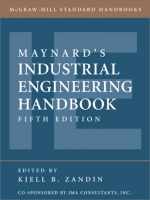Tab Article
Brought fully up to date by expert Kjell Zandin, Maynard’s Industrial Engineering Handbook, Fifth Edition puts exhaustive application-driven coverage of industry principles and practices, materials and systems, at your fingertips. Covering everything from work measurement and material flow, to facilities and quality control, this unparalleled reference is nothing less than the most in-depth, hands-on IE reference available. Designed for industrial engineers who are challenged to do more, in more arenas, this new edition introduces you to both traditional and the latest, most efficient, and cost-effective IE methods and technologies. In 133 solution-packed chapters--90 percent completely new--from 176 expert contributors worldwide, you can explore the Kazien approach to methods engineering, design for assembly, statistical quality control, lean manufacturing, agile production, demand flow technology, and much, much more. You’ll be brought up to speed on breakthroughs in information technology, computer simulation, sensors and controls, economic analyses, robotics, planning, management, organization, and more. 24 case studies illuminate real-life applications, from company turnarounds using IE techniques to neural network applications and implementing a paperless warehouse management system.


